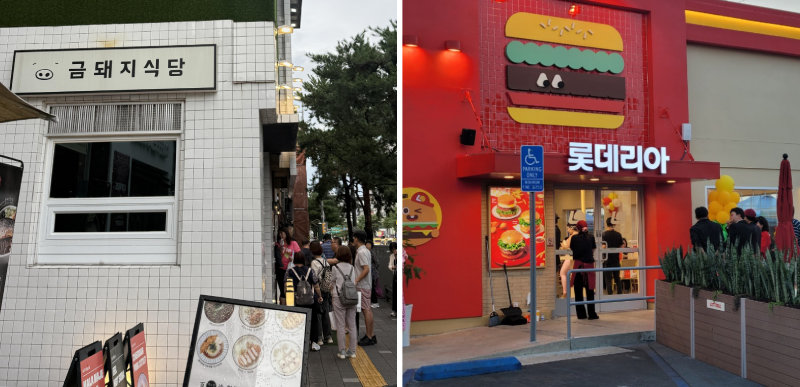The term "Hansik" (Korean food) may feel confined within the framework of national cuisine, but K-food, as viewed internationally, is different. Riding on the success of the Netflix animation 'K-Pop Demon Hunters,' K-food is emerging as a key player in the global dining industry, reshaping it as a protagonist and becoming an important player in the world food culture. Recently, as Korean dining brands have expanded primarily into the Asian and North American markets, K-food is becoming a tangible business opportunity rather than just a cultural experience.
Five months ago, 'Geumdwaeji Sikdang,' which opened in Taipei, the capital of Taiwan, has been fully booked from 11 a.m. to 1 a.m. the next day. This is surprising, given that grilling meat for lunch is not a common culture. Geumdwaeji Sikdang's strategy was to maintain originality rather than localize the menu. The restaurant has not overlooked the quality of meat, the sauces that accompany it, and the unique service spirit of Koreans. It delivers the unique experience of Korean cuisine to local consumers, not just selling pork belly but also through the cheerful and skilled staff's grilling methods, the culture of wrapping food in leaves, and the harmony of side dishes.

‘Geumdwaeji Sikdang’ main branch (left photo), which has expanded to Taiwan while maintaining originality over menu localization, and the first U.S. Lotteria store opened last month in Fullerton City, California. K-restaurants are gaining attention with a differentiated position in the global culinary ecosystem. Provided by Food Director Kim Yoo-kyung and Lotte GRS
Experiential dining aligns with global food trends, and from a business perspective, the focus should be on investing in workforce training. Before the official opening, local Taiwanese staff were brought to the Korean main branch for at least three months of training to impart Korean-style service and meat grilling techniques. Although this increases initial fixed costs, it is interpreted as an investment in maintaining brand trust and a premium image in the long run. Geumdwaeji Sikdang adopts a positioning strategy of premium popularization. The essence of the meal remains popular, but the service and ingredient management maintain a premium standard. This is a core competitive edge that absorbs new consumer bases while retaining originality during the localization process.
'Olhso House,' which opened in San Mateo, California, reinterprets K-barbecue in a new form, presenting a model for the so-called second-generation Korean restaurants. It is also the first overseas venture for CEO Han Sung-il, who has successfully operated more than six dining establishments in Korea, including 'Ushiya,' 'Robatatan-yo,' and 'Pungro.'
The change from the initial name 'All-So (Beef)' to 'Olhso' for consumer friendliness demonstrates differentiation in brand naming strategy beyond mere language. The intuitive message of 'right, correct' provides global consumers with a positive perception and easy pronunciation. In the U.S. market, where exporting Korean beef is not possible, local beef was used, undergoing dozens of tastings to replicate high quality, and overcoming U.S. fire regulations to achieve a charred flavor. Through the Olhso guide, which details how to enjoy grilled meat, and a culture-transmission service where servers grill and explain the meat at the table, customers leave with memorable experiences.
CEO Han states, "The era of first-generation Korean restaurants is over." He advises that overseas, restaurants must evolve into stable dining establishments that offer high quality and enjoyable experiences, rather than just 'Korean' or 'unique experiences.'
The U.S. is the world's most competitive fast-food market. Despite the presence of strong local and global players like 'McDonald's,' 'Burger King,' 'In-N-Out,' and 'Shake Shack,' the challenge of the Korean brand 'Lotteria' might have seemed reckless, but the straightforward approach of 'The Original K-Burger' worked. The first store opened in Fullerton, California, attracted over 1,000 visitors daily for a month, comparable to the daily average number of customers at the top five Lotteria stores in Korea.
By introducing signature menus like Rice Burger, Bulgogi Burger, and Shrimp Burger, Lotteria created a K-burger category that did not exist in the existing U.S. market. It offered a new choice in the patty burger-dominated American culture and introduced new local menus reflecting the needs of wellness and Gen Z consumers, such as rice bowls and rice bun menus. The large Korean sign at the store front, Korean-style friendly service, and Gyeongbokgung-inspired interior maintain branding identity, showing a balance of brand consistency and flexible localization.
Originality strengthens brand trust, and localization should be seen as a 'variation in expression' rather than a 'modification of taste.' K-restaurants are gaining attention as a new genre of culture in the global market, beyond the simple framework of dining. For investors, it represents a new growth sector, and for global dining industry stakeholders, it signifies a new axis of collaboration and competition. Korean cuisine is no longer unfamiliar to foreigners. K-food is growing as a powerful brand group with a differentiated position in the global culinary ecosystem. It is hoped that the essence of taste and experience is preserved while innovation in expression and delivery continues.
ⓒ dongA.com. All rights reserved. Reproduction, redistribution, or use for AI training prohibited.
Popular News